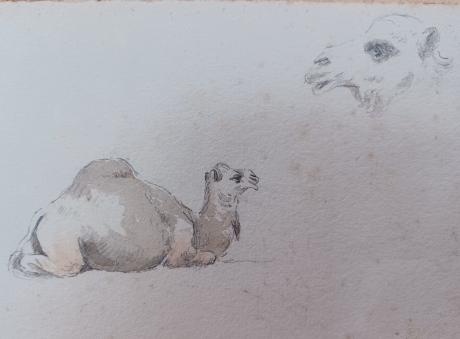The dromedary (Camelus dromedarius), also known as the dromedary camel, Arabian camel and one-humped camel, is a large camel of the genus Camelus with one hump on its back. It is the tallest of the three camel species; adult males stand 1.8–2.4 m (5 ft 11 in – 7 ft 10 in) at the shoulder, while females are 1.7–1.9 m (5 ft 7 in – 6 ft 3 in) tall. Males typically weigh between 400 and 690 kg (880 and 1,520 lb), and females weigh between 300 and 540 kg (660 and 1,190 lb). The dromedary's distinctive features include its long, curved neck, narrow chest, a single hump and long hairs on the throat, shoulders and hump. The coat is generally a shade of brown. The hump, 20 cm (7.9 in) tall or more, is made of fat bound together by fibrous tissue.
The dromedary feeds on foliage and desert vegetation; several adaptations, such as the ability to tolerate losing more than 30% of its total water content, allow it to thrive in its desert habitat. Mating occurs annually and peaks in the rainy season; females bear a single calf after a gestation of 15 months. It is mainly active during daylight hours and form herds of about 20 individuals, which are led by a dominant male.
The dromedary has not occurred naturally in the wild for nearly 2,000 years. It was probably first domesticated in the Arabian Peninsula about 4,000 years ago, or in Somalia where there are paintings in Laas Geel that figure it from 5,000 to 9,000 years ago. In the wild, the dromedary inhabited arid regions, including the Sahara Desert. The domesticated dromedary is generally found in the semi-arid to arid regions of the Old World, mainly in Africa and the Arabian Peninsula, and a significant feral population occurs in Australia. Products of the dromedary, including its meat and milk, support several North African tribes; it is also commonly used for riding and as a pack animal.
Lionel Grimston Fawkes, grandson of Walter Ramsden Hawkesworth Fawkes (an MP and patron of Turner), began his military training at the Royal Military Academy, Woolwich, he became professor of military topography there... By 1883 he was Dominic Gamble’s aide-de-camp in Jamaica. In 1885 he entered Staff College, Sandhurst. He became a Colonel in the Royal Artillery and later a Justice of the Peace. In 1891 he married Lady Constance Eleanor Kennedy, daughter of a Scottish peer. He was Professor of Military Topography at the Royal Military Academy from 1895 to 1900. By 1923 he and his wife had moved to Canada, purchasing the Point Comfort Hotel on Mayne Island and changing its name to Culzean after Constance’s ancestral home, Culzean Castle. They remained at Culzean for the rest of their lives.
Colonel Fawkes was a very accomplished artist and illustrator. His water-colours are held in collections around the world. Their married daughter, Lois died in 1919 leaving a one year old son Lawrence. Tragedy struck the Fawkes family again in 1921, when their other daughter, Monica, also died. This was all too much for the Colonel and Lady Constance and in 1924 they emigrated to Mayne Island, British Columbia with their son-in-law and grandson

